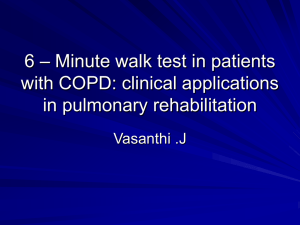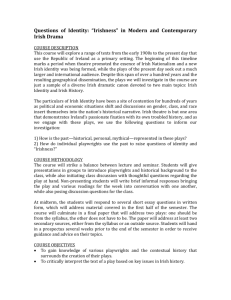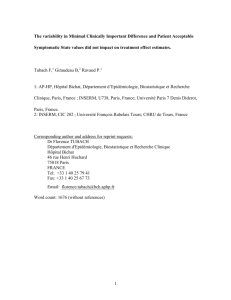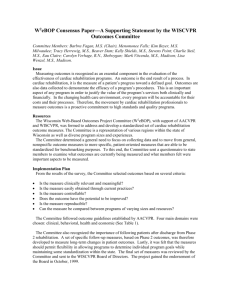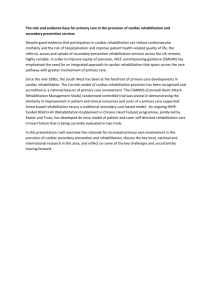40. ATS statement: guidelines for the six
advertisement
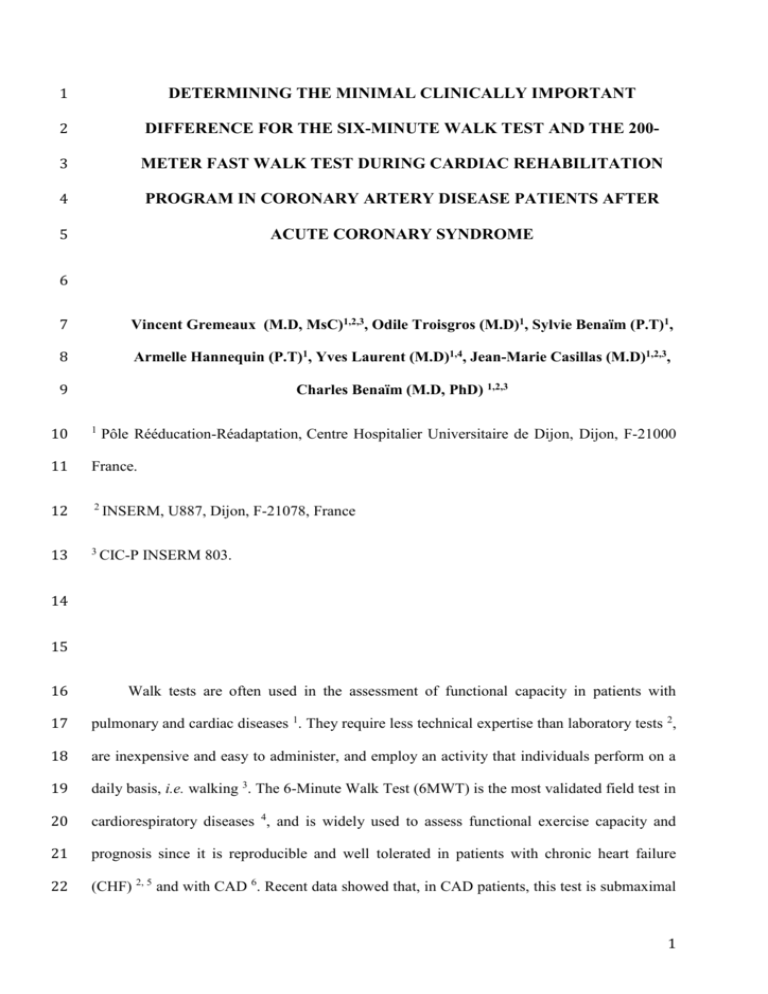
1 DETERMINING THE MINIMAL CLINICALLY IMPORTANT 2 DIFFERENCE FOR THE SIX-MINUTE WALK TEST AND THE 200- 3 METER FAST WALK TEST DURING CARDIAC REHABILITATION 4 PROGRAM IN CORONARY ARTERY DISEASE PATIENTS AFTER 5 ACUTE CORONARY SYNDROME 6 7 Vincent Gremeaux (M.D, MsC)1,2,3, Odile Troisgros (M.D)1, Sylvie Benaïm (P.T)1, 8 Armelle Hannequin (P.T)1, Yves Laurent (M.D)1,4, Jean-Marie Casillas (M.D)1,2,3, 9 Charles Benaïm (M.D, PhD) 1,2,3 10 1 11 France. 12 2 INSERM, U887, Dijon, F-21078, France 13 3 CIC-P INSERM 803. Pôle Rééducation-Réadaptation, Centre Hospitalier Universitaire de Dijon, Dijon, F-21000 14 15 16 Walk tests are often used in the assessment of functional capacity in patients with 17 pulmonary and cardiac diseases 1. They require less technical expertise than laboratory tests 2, 18 are inexpensive and easy to administer, and employ an activity that individuals perform on a 19 daily basis, i.e. walking 3. The 6-Minute Walk Test (6MWT) is the most validated field test in 20 cardiorespiratory diseases 4, and is widely used to assess functional exercise capacity and 21 prognosis since it is reproducible and well tolerated in patients with chronic heart failure 22 (CHF) 2, 5 and with CAD 6. Recent data showed that, in CAD patients, this test is submaximal 1 23 exercise, approximately corresponding to the first ventilatory threshold (VT) 24 performed early after a myocardial infarction (MI) 8, and can be used to assess cardiac 25 rehabilitation programs 9 , 10. 26 6, 7 . It can be The 200-Meter Fast Walk Test (200MFWT) has recently been developed in healthy 27 elderly people and in CAD patients 28 functional capacity after a training program in elderly 12 and CAD patients 7. The 200MFWT 29 explores higher exercise intensities than does the 6MWT, both of which could be of interest 30 in cardiac rehabilitation. Indeed, recent studies suggest that vigorous exercise training and/or 31 high intensity aerobic interval exercise may be superior to moderate intensity exercise in that 32 they increase aerobic capacity to a greater extend in CAD patients 13, 14. 7, 11 . It has also been used to assess improvements in 33 Field walk tests are objective measures that provide a means to monitor response to 34 treatment 3. The interpretation of functional changes can guide clinical management and can 35 be primary endpoints in interventional or observational studies. It is thus important to 36 determine whether a change in function is clinically relevant or not. One method to answer 37 this question quantitatively is to determine the minimal clinically important difference 38 (MCID) for the test used. 39 The Minimal Clinically Important Difference (MCID) is a concept defined as “the smallest 40 difference in score in the domain of interest which patients perceive as beneficial and which 41 would mandate, in the absence of troublesome side effects and excessive cost, a change in the 42 patients management” 43 indicates the amount of change required to exceed measurement variability 44 when interpreting clinical measures, it is important to consider that, even though small 45 changes may be statistically significant, they may not be clinically relevant 46 values are therefore important to appreciate the clinical relevance of observed changes, at 15 . The MCID is different from the Minimal Detectable Change, that 16, 17 . Indeed, 16, 18 . MCID 2 47 both the individual and group levels. As individuals interpret “meaningful change” 48 differently, depending on a multitude of factors (e.g. prior level of function, age, physical 49 environment ), the MCID is a dynamic and context-specific concept, and derivations of the 50 MCID are usually estimated only for a specific population at a particular stage of recovery 19. 51 Because estimation of the MCID is a process evolving from multiple perspectives, it is 52 important to estimate the MCID for key clinical outcome measures, such as walking ability in 53 CAD patients. Indeed, walking is one of the most basic human motor activities and plays a 54 key role in patients’ participation. 55 56 57 Numerous methods to derive the MCID have been described 15, 16, 20-23 . They are usually divided into 2 categories: distribution-based and Anchor-based 21. Anchor-based methods involve comparing a patient’s change score with another 58 measure of clinically relevant change 59 compared with another measure of change. An example of external criterion may be the 60 change perceived by the patient or clinician 61 abilty). The other measure of change used for comparison is usually an objective data, such as 62 walking distance. Anchor based methods have the advantage of being more clearly 63 understood because change are related to a clear clinical observation 64 determine that a change is considered important to the patient, physician or researcher, and 65 even the health care authorities or society at large 27. 66 24 . In this method, an external criterion of change is 16, 25 (e.g. self-perceived improvement in walking 26 . This helps to Distribution-based methods, such as the standard error of the measure (SEM) 28 and 67 the effect size 68 population. Concurrent use of the two approaches is recommended to evaluate the effects of 69 the methodology on the final value 30. 29 , are built on the statistical and psychometric properties of the measure in a 3 70 There is as yet no accepted threshold for clinically significant change in cardiac 71 diseases in the 6MWT walked distance (6MWD) 72 (200MFWTT). 31 , nor in the 200MFWT time 73 The aims of this study were (1) to prospectively determine the MCID for the 6MWD 74 and the 200MFWTT in patients with CAD and (2) to determine if there was any difference 75 between the MCID determined by patients and those assessed by their therapists. 76 77 78 METHODS 79 Participants 80 Patients who were referred to the cardiac rehabilitation department of Dijon University 81 Hospital following an acute coronary syndrome were invited to participate. Patients were 82 eligible if they had been admitted to an ambulatory cardiac rehabilitation program after 83 percutaneous transluminal coronary angioplasty or coronary stenting, following an acute 84 coronary syndrome. Only patients admitted within 2 months after the acute coronary 85 syndrome, under optimal medical treatment according to the latest recommendations 32 (i.e. - 86 blockers; Angiotensin converting enzyme inhibitors or Angiotensin receptor blockers, anti- 87 platelet agents, statins) were included, with no restrictions regarding body mass index. All 88 gave their written consent after being clearly advised about the protocol, which had been 89 approved by the Institutional Ethics Committee and conformed to the principles outlined in 90 the Declaration of Helsinki. Exclusion criteria were: residual myocardial ischemia or unstable 91 angina; chronic heart failure, defined by (a) Framingham clinical criteria 92 ventricular ejection fraction <45%, measured by echocardiography using the Simpson 93 method; severe valve disease; diabetes; pulmonary hypertension); chronic respiratory 33 , (b) a left 4 94 insufficiency; symptomatic lower limb artery disease; severe renal insufficiency; and any 95 associated deficiency such as severe orthopaedic troubles limiting use of the lower limbs and 96 that were more limiting to effort than the cardiac disease itself. 97 Protocol 98 99 All patients received an 8-week cardiac rehabilitation program that included two components: 100 - Personalised training tailored on the basis of the results of a stress test, performed on 101 treadmill using the Bruce modified protocol 102 41 103 the Dijon physical activity score questionnaire 104 target heart rate (HR) zone derived from the maximal HR at the end of the stress test.It was 105 calculated using the Karvonen formula 35 as follows: training HR = rest HR + 75% (max HR 106 – rest HR). During training sessions, Borg scale with level 6 to 20 was also used 107 target was set between 13 and 15. 108 - Individual and group educational interventions based on the patient’s risk factors 37. 34 , before entering the rehabilitation programme , and individualized on the basis of preliminary physical activity habits, determined using 11 . The training intensity was prescribed at a 36 . The 109 The training program was in line with the latest recommendations in the field 37-39, 110 and consisted of one-and-a-half-hour sessions, 3 days a week over 8 weeks. Patients had to 111 perform two 30-minute sessions of two different aerobic exercises (walking and bicycle or 112 arm cycling) with a global warm up and cool down, and 20 minutes of circuit weight training 113 adapted to each patient's capacities (solicited muscles groups were leg extensors and flexors, 114 ankle dorsiflexors and plantar-flexors, elbow flexors and extensors, Latissimus dorsi). 115 Patients performed stress tests and walk tests as usual at the beginning and at the end of 116 the rehabilitation program. The initial walk tests were performed 2 to 4 days after the ET. During 5 117 this interval, all patients performed a trial run of each walk test to familiarize them with the test 118 and the path. They were repeated at the 6th and 12th training session. After each evaluation, and 119 before giving the result of the test, the physiotherapist asked the patients the following question 120 “Has there been any change in your walking ability since the last walking tests” ? The responses 121 were made on a 9-level Likert scale, with a score of 0 indicating no change, positive scores 122 indicating improvement, and negative scores indicating worsening walking ability. Change was 123 scored as follows: (-4): much worse; (-3): worse; (-2): slightly worse, meaningful; (-1): very 124 slightly worse, not meaningful; (0): Unchanged; (1): very slightly better, not meaningful; (2): 125 slightly better, meaningful; (3) : better; (4): much better. 126 In order to study inter-observer agreement between the patient and his therapist, the 127 same question was asked to the physiotherapist supervising the patient’s training, using the 128 same 9-level scale. All ratings were completed before giving the result of the tests to ensure 129 that both participants and clinicians were blinded to the performance, as recommended for the 130 assessment of change in subjects in MCID studies 15. 131 During the walk-tests, patients wore a telemetric device (Teleguard, GE Medical 132 Systems, Denmark). Blood pressure was measured before and immediately after each test in 133 the left arm using a standard cuff mercury sphygmomanometer. Patients were also asked to 134 rate their dyspnea on a Borg scale at the end of each test, and any clinical symptoms such as 135 angina were recorded. Both walk tests were supervised by a physiotherapist blinded to the 136 stress-test results and to the training group of the patient. 137 The 6MWT was performed on a 50-meter unobstructed path. The patients were 138 instructed to walk at a self-selected pace from one end of the path to the other and back, in 139 order to cover as much distance as they could during the allotted time. The time was called 140 out every 2 minutes. Standard encouragement at 30-second intervals was provided. Slowing 141 down and stopping to rest were permitted. At the end of 6 minutes, the total distance walked 6 142 in meters (m) was measured. These technical aspects are in line with the American Thoracic 143 Society recommendations for the 6-minute walk test 40. 144 The 200-meter fast walk test consisted of walking twice up and down the 50-m long 145 path in the hospital corridor as fast as possible, without running. Standard encouragement was 146 provided at mid-distance. Slowing down and stopping to rest were permitted. The time taken 147 to perform the test was measured in seconds 7, 11. 148 149 150 151 Statistical Analyses Change in walking distance (for the 6MWD) and in time (for the ) were expressed as an absolute distance or time, by substracting the initial result from the discharge result. 152 For the anchor-based approach, patients were dichotomized based on their self 153 assessment of clinical change. A cutoff of 2 (slightly better, meaningful) was used to identify 154 patients who achieved an MCID (score 2) from those who did not (score <2). As previously 155 described, the mean score change for the smallest meaningful change (i.e. 2) was taken as 156 the MCID for both walk tests 41, 42. Then, the means of those subjects who achieved an MCID 157 were compared with those who did not using a one-way ANOVA. The positive predictive 158 value (PPV), negative predictive value (NPV), sensitivity and specificity for change in the 159 6MWD and in 200MFWTT were calculated and a Receiver Operating Characteristic (ROC) 160 curve obtained. Given the objective of this work, i.e. to estimate the minimal improvement in 161 the 6MWD or in the 200MFWTT that would lead the patient to be satisfied with his outcome, 162 we chose to consider PPV and NPV rather than sensitivity and specificity to identify the 163 MCID of these tests. 7 164 This analysis was repeated with patients dichotomized according to their 165 physiotherapist’s assessment of clinical change, in order to identify the MCID from the 166 therapist’s point of view. The same cutoff of 2 (slightly better, meaningful) was used to 167 distinguish between patients who achieved an MCID and those who did not. 168 Concerning the distribution-based methods, we used the SEM to estimate the MCID. 169 The SEM is defined as 1(1-r), where 1 is the baseline standard deviation and r is the 170 test-retest reliability. One SEM is supposed to be a close approximation of the MCID 28. The 171 intraclass correlation coefficients used for test-retest reliability were calculated from data of a 172 previous study 7, and were set at 0.71 for the 6-MWT and 0.87 for the 200-MFWT. 173 Agreement between the ratings of patients and physiotherapists was studied using 174 Cohen’s κ correlation coefficient. Coefficients from 0 to 0.4 reflect a weak association, 0.4 - 175 0.75 a moderate association, and above 0.75 a strong association 43. 176 Improvement in maximal exercise capacity between patients achieving MCID and 177 those who did not were compared using a Student t-test, and correlations between 178 improvement in 6MWD and improvement in maximal exercise capacity were tested using 179 Pearson correlation coefficient. 180 Data were recorded using Excel software for Windows, and statistical analysis was 181 performed using NCSS 2004 for Windows. The threshold for significance was set at 182 p<0.05. 183 Sample Size 184 As walk tests are usually performed only at the beginning of the rehabilitation program and at 185 discharge, we could not calculate an estimated sample size based on the evolution of 186 performance in tests repeated every 2 weeks. According to the latest studies concerning 8 187 MCID in the 6MWD in COPD and post-stroke functional measures 41, 42, 44, and anticipating a 188 10% dropout from the program, we initially planned to include 80 patients. 189 190 RESULTS 191 Participants 192 Eighty-one patients were recruited, and all of them completed the rehabilitation 193 program. Two patients did not complete the 3rd evaluation (both had to stop training for 2 194 weeks for personal or family reasons). The demographic and anthropometric characteristics of 195 the 81 included patients are described in table 1. 196 197 Walk tests and maximal exercise tests results 198 Overall, there was a mean improvement of 73.2 56.5 meters in the 6MWD (15.7 199 12.2%), and of 5 17.7 seconds in the 200-MFWT time (-5.3 10.8%) (figure 1). All of the 200 walk tests were well tolerated both before and after rehabilitation, and were performed 201 without being prematurely interrupted or stopped. No significant arrhythmias were observed 202 on the telemetric device recordings. The mean rate of perceived exhaustion for the 6MWT 203 and the 200MFWT were 14.9 ± 0.8 and 16 ± 0.9 before, and 14.6 ± 0.9 and 16.1 ± 1 after, 204 respectively. All patients significatively improved maximal exercise capacity from 7.2 ± 1.7 205 METS at baseline to 9 ± 2.1 METs at the end of the training period (mean improvement 25 ± 206 13.8% %, p<0.01), without significative change in the maximal heart rate (121.2 ± 13.8 and 207 126.4 ± 16, respectively). There were no significative difference in the improvement of 208 maximal exercise capacity between those patients who achieved MCID and those who 209 did not between the 2nd and 3rd walk tests (mean improvement: + 26.4 ± 10.2% Vs + 24.7 9 210 ± 15.4%, respectively). Finally, improvement in 6MWD and in maximal exercise capacity, 211 expressed in METs, were moderately correlated (r= 0.59, p<0.05) 212 213 Anchor-Based Estimation of the MCID 214 The distribution frequency of the change scores concerning walking ability, from the 215 patients’ point of view, between the initial and the 2nd evaluation, as well as between the 2nd 216 and the 3rd, and the 3rd and the final evaluation, are shown in figure 2. The distribution was 217 best balanced between the 2nd and 3rd evaluation. We thus considered that this period of the 218 rehabilitation program (between the 6th and 12th training session) was the best suited for the 219 calculation of the MCID, since during this period the assessments of the patients varied the 220 most widely. Seventy-nine patients completed the 2nd and 3rd evaluation. 221 At this time, 40 patients rated themselves as 2, while 39 reported little or no 222 improvement, or even a worsening of perceived walking ability (score <2). The mean change 223 in the 6MWD in those participants who classified themselves as improved was + 23.3 ± 34.8 224 meters, compared with – 6.5 ± 31 meters in those who reported a small change or worsening 225 (figure 3, A). The mean change in the 200MFWTT in those who classified themselves as 226 improved was – 1.4 ± 6.8 seconds, vs. + 0.1 ± 4.8 seconds in those who reported little or no 227 change, or worsening. There was a significant difference between the 2 groups for the 6MWD 228 (p< 0.001) whereas no significant difference was found for the 200MFWTT (p=0.26). 229 The PPV and NPV, sensitivity and specificity for the 6MWD and the 200MFWT 230 using patients’ rating of change are reported in table 2. Concerning the 6MWD, for an 231 MCID between 21 and 27m, the PPV ranged between 0.8 and 0.9, and the NPV ranged 232 between 0.63 and 0.66 (table 2, A). An MCID of 25 meters corresponded to a sensitivity of 233 0.55 and a specificity of 0.92, with an area under the curve (AUC) of 0.78 (95% CI: 0.65 – 10 234 0.86). Concerning the 200MFWT, for an MCID between -1 and -6 seconds, the PPV and 235 NPV were poor, ranging from 0.45 to 0.47, and from 0.33 to 0.41, respectively (table 2, B). 236 An MCID of -2 seconds corresponded to a sensitivity of 0.67 and a specificity of 0.14 (AUC : 237 0.4; 95% CI: 0.27 - 0.53) (Figure 4). 238 Concerning the physiotherapists’ ratings, 58 patients were rated 2 and 21 rated <2. 239 The mean change in the 6MWD in the patients classified as improved by the physiotherapist 240 (2) was + 15.2 ± 4.6 meters, compared with – 9.9 ± 7.6 meters in those who were classified 241 as stable or worsened (<2) (figure 3, B). The mean change in 200MFWTT in those judged as 242 improved was – 1.3 ± 1.2 seconds, vs. + 1.04 ± 1 seconds in those judged little improved or 243 stable or worsened. There was a significant difference between the 2 groups for the 6MWD 244 (p< 0.01) whereas no significant difference was found for the 200-MFWT performance (p= 245 0.12). 246 The PPV and NPV, sensitivity and specificity for the 6MWD and the 200MFWTT 247 using physiotherapists’ rating of change are reported in table 3. Concerning the 6MWD, for 248 an MCID between 15 and 27m, the PPN ranged between 0.84 and 0.95, and the NPV ranged 249 between 0.34 and 0.38. An MCID of 25 meters corresponded to a sensitivity of 0.41 and a 250 specificity of 0.95 (AUC: 0.7; 95% CI: 0.55 –0.81). Concerning the 200MFWTT, for an 251 MCID between -1 and -6 seconds, the PPN ranged between 0.68 and 0.71, and the NPV 252 ranged between 0.11 and 0.2. An MCID of -2 seconds corresponded to a sensitivity of 0.67 253 and a specificity of 0.14, (AUC: 0.38; 95% CI :0.22 –0.5). 254 255 Cohen’s κ correlation coefficient between patients’ and physiotherapists’ judgment was 0.17 for the 6-MWD and 0.29 for the 200-MFWTT, reflecting poor agreement. 256 When considering patients who rated themselves <2, 16 were considered stable or 257 worsened by the physiotherapist (score < 2), and 23 were considered improved (score 2) 11 258 (table). There was no significant difference between patients classified <2 and those classified 259 2 by the physiotherapist for either the 6MWD or the 200MFWTT (table 4). Moreover, there 260 was also no significant difference in the HR variation between the 2 evaluations for the 2 261 groups (table 4). 262 263 Distribution-Based Estimation of the MCID 264 When considering the patients’ self assessment, the SEM for the 6MWD was 23 265 meters using the baseline standard deviation for the 6MWD and an intraclass correlation 266 coefficient of 0.71. Concerning the 200MFWT, using an intraclass correlation coefficient of 267 0.87 the SEM for the 200MFWTT was - 4.2 seconds. 268 269 Using the same methodology with the physiotherapists’ judgment, the SEM was 36 meters for the 6MWD and -5.5 seconds for the 20MFWT. 270 Overall, 76 out of 81 patients achieved an improvement of over 25 meters in the 271 6MWD. When considering the progression between the 2nd and 3rd evaluation, 23 had 272 improved the 6MWD by over 25 meters, whereas 54 had improved by less than 25 meters. 273 There was no difference in the initial 6MWD among patients who achieved the MCID (491 274 55 meters) and those who did not (486 56 meters). 275 276 DISCUSSION 277 We estimated the MCID for the 6MWD at approximately 25 meters among CAD 278 patients who recently suffered an ACS and who had benefited from cardiac rehabilitation. 279 This estimate was consistent, whatever the estimation method used (anchor-based or 12 280 distribution-based). Using the same methodology, we could not determine an MCID with 281 satisfactory metrological qualities for the 200MFWTT. 282 To our knowledge, this is the first study to evaluate the MCID for walk tests among 283 CAD patients. A previous study determined an MCID for the health status in patients with 284 heart disease, but considered health-related quality of life scores, and used a different 285 approach, based on a consensus reached by a panel of physicians 286 anchor specific to functional walking capacity. Our work is thus complementary, as walking 287 tests and quality of life questionnaires measure different constructs 288 walking performance should not be used to infer changes in health-related quality of life, 289 irrespective of whether the MCID is achieved. 290 45 . Here, we used a patient 46 . Indeed, changes in The MCID of 25 meters for the 6MWD identified in this study is similar to that 291 recently reported by Holland et al. among patients with diffuse parenchymal lung disease 292 and COPD patients 293 patients can identify clinical change using the ROC method, rather than using the average 294 distance associated with clinical change in a group of patients. Using this cutoff, the positive 295 predictive value was 0.9. This means that, when patients improve their 6MWD by 25 meters, 296 there is a 90% chance that they will feel a real improvement in their walking performance. 297 This was also associated with a specificity of 0.92, and a sensitivity of 0.55, meaning that 298 when patients do perceive a clinical change, there is a 55% chance that their walking capacity 299 has improved by more than 25 m. 300 44 47 . As in the latter study, we identified a threshold distance at which Unlike the study of Holland et al. among COPD patients 44 , we did not find a 301 difference in the absolute change in 6MWD depending on the baseline walking distance. This 302 might be due to the difference in the sample, as our patients were younger, and showed a 303 higher baseline performance with less variability. This could also be due to the different 304 nature of the disease itself. 13 305 The majority of patients achieved the estimated MCID after rehabilitation (93%). We 306 chose to estimate the MCID between the 6th and 12th session, in order to avoid a skewed 307 distribution of perceived change scores (figure 1), and to minimize recall bias. Thus, at this 308 time, only 36% had achieved the MCID. This means that we had patients with change scores 309 greater than the calculated MCID values who considered their walking capacity unchanged or 310 worsened Conversely, other patients with change scores less than the calculated MCID 311 considered their walking capacity improved (score 2). Moreover, there was no difference in 312 maximal exercise capacity improvement between patients achieving MCID for the 6MWD 313 between the 2nd and 3rd evaluation and those who did not. This seems logical, as the 6MWT 314 remains a submaximal walk tests, and as the correlation between improvement in 6MWD and 315 maximal exercise capacity improvement was moderate, as previously reported 6. Our MCID 316 values should thus be interpreted with caution, particularly when making judgments about 317 individual patients, and exercise capacity assessment remains the gold standard for prognosis. 318 Studies of retrospective change have shown that subjects tend to judge their 319 assessments of change based on their current condition, remembering backwards in time from 320 that point rather than remembering their initial condition and working forward 48. Thus, 321 estimating perceived change every 6 to 8 sessions allowed us to minimize this bias, even 322 though this methodology is not as strong as would be a prognostic study of predicted change. 323 324 The estimation of the MCID for the 6MWD was different when determined by the 325 patient or the physiotherapist. Previous studies in other diseases concerning agreement 326 between patients’ and clinicians’ ratings of change showed inconsistent results, ranging from 327 poor 328 change given the little time spent actually observing patients 329 that other health professionals, such as physiotherapists, who are more familiar with the day- 330 to-day functioning of patients, would have an estimation of clinical change closer to that of 49, 50 to good 26 agreement. Physicians may have a skewed perspective on functional 51 . However, one could think 14 331 patients. This was not the case in our study, as there was poor agreement between change 332 assessed by patients and that assessed by physiotherapists (Cohen κ correlation coefficient = 333 0.17). For example, among patients who rated themselves <2, 16 were considered stable or 334 worsened by the physiotherapist (score < 2), and 23 were considered improved (score 2). 335 However, there was no significant difference between these 2 groups for the 6MWD (table 4). 336 Physiotherapists may take into account many subjective (general appearance of the patient, 337 mood, other complaints, etc.) and objective data (total work on ergometers, HR during 338 training sessions) in their judgment, related to their own experience and history. Some of 339 these data were probably considered more important by the physiotherapist than by the 340 patients in interpreting the perception of clinical change. However, in our study, there was no 341 significant HR variation between the 2nd and the 3rd evaluation. This might not have affected 342 the change perceived by the physiotherapist. Future studies may include regression analyses 343 to identify the components of relevant clinical change for the therapist and the patient. 344 Our study failed to identify an MCID with satisfactory metrological qualities for the 345 200MFWT. The anchor-based method did not show a significant difference in means between 346 patients rating <2 and those rating 2. A 4.2-second improvement in the 200MFWTT was 347 determined as the MCID when using the distribution method. However, this finding has to be 348 interpreted very cautiously as the ROC method did not allow us to identify a threshold with 349 sufficient metrological qualities for a time improvement at which patients can identify a 350 clinical change. The 200MFWT test explores higher exercise intensities than does the 6MWT 351 7 352 maximal capacity. Indeed, the 6MWT is submaximal moderate exercise, approximately 353 corresponding to the first VT 354 perception of their walking ability during this test, which may better reflect their daily 355 activities than the 200MFWT, which is more like running to catch a bus, for example. The . It could be harder for a patient to interpret his feelings during a test that is closer to his 6, 52 . Thus, it might be easier for patients to have a better 15 356 200WFWT might be more useful as a tool to help design or assess high intensity 357 rehabilitation programs, such as interval training. 358 The sensitivity and specificity of tests are often used to choose a cutoff for the 359 significance of a clinical or biological variable. Here, we chose the PPV and NPV to identify 360 a meaningful cutoff for the MCID. Indeed, we chose these metrologic properties to find 361 answers to the question raised: will a patient who improves beyond the identified MCID 362 perceive a clinical change? Based on our results, with a 25-meter cutoff, we can affirm that in 363 this population, 90% of patients who improved their 6MWD by more than 25 meters 364 perceived a meaningful clinical change in their walking ability. Conversely, among patients 365 who improved by less than 25 meters, 66% did not perceive any change. The PPV is 366 influenced by the prevalence of the studied parameter in the population considered. However, 367 the anthropometric characteristics and baseline walk performance of our sample was quite 368 similar to that of other studies in the field 7, 9. 369 By defining the threshold for clinically important change, we improve our ability to 370 interpret the effects of cardiac rehabilitation programs in routine clinical practice as well as in 371 randomized clinical trials that assess the effectiveness of interventions. Thus, an MCID 372 reference improvement of 25 meters for the 6MWD could serve as an explicit therapeutic goal 373 for rehabilitation or other therapeutic interventions that aim to improve walking ability and 374 participation levels for CAD patients. Indeed, a valid MCID for 6MWD improvement is 375 useful for the clinical interpretation of individual rehabilitation programs, but also the clinical 376 significance of intervention studies that may find statistical improvements in 6MWD but may 377 not achieve a clinically meaningful threshold. Moreover, sample size heavily influences the 378 statistical significance of an improvement in performance in a clinical trial. The clinically 379 interpretable effects of a training program on measurements of performance can be examined 380 according to standards of meaningful change by comparing the proportion of treatment and 16 381 control groups who achieve change and calculating the number needed to treat 382 sample size estimates are needed in the planning stage of research studies and should be based 383 on the ability to detect clinically significant levels of change. 53 . Finally, 384 385 386 Study Limitations 387 Our study in one cardiac rehabilitation department comprised a relatively small sample 388 of stable CAD patients and included very few women. Moreover, they all benefited from 389 standardized care during the acute phase, which may vary from one cardiology acute care 390 department to another. Thus, we cannot generalize our results to the whole population of 391 CAD patients. Future studies with larger sample sizes including patients with different 392 functional statuses are now needed to refine our estimates and to determine how MCID values 393 are affected by time since the MI, by the severity and/or clinical features of the initial MI, and 394 by the initial acute care procedure. 395 Even though we chose to assess the MCID at the period with the widest diversity in 396 degrees of self-perceived change, very few patients (4) reported a decline in walking ability. 397 This seems logical, given the well-known benefits of cardiac rehabilitation programs. Among 398 these 4 patients, only one really had a lower 6MWD (-5 meters). We were therefore unable to 399 assess whether the MCID for decline differed from the MCID for improvement, as has 400 previously been reported 54. 401 Finally, only a small number or physical therapists participated in the 402 assessment of change, and all of these had specialized in cardiac rehabilitation. Future studies 403 should include more physiotherapists from multiple settings. 404 17 405 CONCLUSIONS 406 Our study provides the first estimates of a minimal clinically important difference, 407 approximately 25 meters, in performance at the 6-minute walk test in a CAD population. This 408 result supports the use of the 6-MWT during cardiac rehabilitation programs in CAD patients 409 after ACS , and will help practitioners and researchers interpret changes in the 6MWD in this 410 population. 411 412 413 414 415 416 Acknowledgments: The authors would like to thank the whole rehabilitation team for their 417 participation in this study. We would also like to thank Dr Dupeyron and Gelis for their 418 unconditional 10-years support. The English was revised by Philip Bastable. 419 18 420 REFERENCES 421 422 423 424 425 426 427 428 429 430 431 432 433 434 435 436 437 438 439 440 441 442 443 444 445 446 447 448 449 450 451 452 453 454 455 456 457 458 459 460 461 462 463 464 465 466 1. Guyatt GH, Thompson PJ, Berman LB, Sullivan MJ, Townsend M, Jones NL et al. How should we measure function in patients with chronic heart and lung disease? J Chronic Dis 1985;38(6):517-24. 2. Lipkin DP, Scriven AJ, Crake T, Poole-Wilson PA. Six minute walking test for assessing exercise capacity in chronic heart failure. Br Med J (Clin Res Ed) 1986;292(6521):653-5. 3. Singh S. The use of field walking tests for assessment of functionnal capacity in patients with chronic airways obstruction. Physiotherapy 1992;78:102-4. 4. Solway S, Brooks D, Lacasse Y, Thomas S. A qualitative systematic overview of the measurement properties of functional walk tests used in the cardiorespiratory domain. Chest 2001;119(1):256-70. 5. Guyatt GH, Sullivan MJ, Thompson PJ, Fallen EL, Pugsley SO, Taylor DW et al. The 6-minute walk: a new measure of exercise capacity in patients with chronic heart failure. Can Med Assoc J 1985;132(8):919-23. 6. Gayda M, Temfemo A, Choquet D, Ahmaidi S. Cardiorespiratory requirements and reproducibility of the six-minute walk test in elderly patients with coronary artery disease. Arch Phys Med Rehabil 2004;85(9):1538-43. 7. Gremeaux V, Deley G, Duclay J, Antoine D, Hannequin A, Casillas JM. The 200-m fast-walk test compared with the 6-min walk test and the maximal cardiopulmonary test: a pilot study. Am J Phys Med Rehabil 2009;88(7):571-8. 8. Nogueira PA, Leal AC, Pulz C, Nogueira ID, Filho JA. Clinical reliability of the 6 minute corridor walk test performed within a week of a myocardial infarction. Int Heart J 2006;47(4):533-40. 9. Verrill DE, Barton C, Beasley W, Lippard M, King CN. Six-minute walk performance and quality of life comparisons in North Carolina cardiac rehabilitation programs. Heart Lung 2003;32(1):41-51. 10. O'Keeffe ST, Lye M, Donnellan C, Carmichael DN. Reproducibility and responsiveness of quality of life assessment and six minute walk test in elderly heart failure patients. Heart 1998;80(4):377-82. 11. Gremeaux V, Iskandar M, Kervio G, Deley G, Perennou D, Casillas JM. Comparative analysis of oxygen uptake in elderly subjects performing two walk tests: the six-minute walk test and the 200-m fast walk test. Clin Rehabil 2008;22(2):162-8. 12. Deley G, Kervio G, Van Hoecke J, Verges B, Grassi B, Casillas JM. Effects of a oneyear exercise training program in adults over 70 years old: a study with a control group. Aging Clin Exp Res 2007;19(4):310-5. 13. Rognmo O, Hetland E, Helgerud J, Hoff J, Slordahl SA. High intensity aerobic interval exercise is superior to moderate intensity exercise for increasing aerobic capacity in patients with coronary artery disease. Eur J Cardiovasc Prev Rehabil 2004;11(3):216-22. 14. Swain DP, Franklin BA. Comparison of cardioprotective benefits of vigorous versus moderate intensity aerobic exercise. Am J Cardiol 2006;97(1):141-7. 15. Jaeschke R, Singer J, Guyatt GH. Measurement of health status. Ascertaining the minimal clinically important difference. Control Clin Trials 1989;10(4):407-15. 16. Beaton DE, Bombardier C, Katz JN, Wright JG, Wells G, Boers M et al. Looking for important change/differences in studies of responsiveness. OMERACT MCID Working Group. Outcome Measures in Rheumatology. Minimal Clinically Important Difference. J Rheumatol 2001;28(2):400-5. 19 467 468 469 470 471 472 473 474 475 476 477 478 479 480 481 482 483 484 485 486 487 488 489 490 491 492 493 494 495 496 497 498 499 500 501 502 503 504 505 506 507 508 509 510 511 512 513 514 515 17. de Vet HC, Terwee CB, Ostelo RW, Beckerman H, Knol DL, Bouter LM. Minimal changes in health status questionnaires: distinction between minimally detectable change and minimally important change. Health Qual Life Outcomes 2006;4:54. 18. Hays RD, Woolley JM. The concept of clinically meaningful difference in healthrelated quality-of-life research. How meaningful is it? Pharmacoeconomics 2000;18(5):41923. 19. Wells G, Beaton D, Shea B, Boers M, Simon L, Strand V et al. Minimal clinically important differences: review of methods. J Rheumatol 2001;28(2):406-12. 20. Jacobson N, Follette W, Revenstorf D. Toward a standard definition of clinically significant change. Behav Ther 1986;17:308–11. 21. Crosby RD, Kolotkin RL, Williams GR. Defining clinically meaningful change in health-related quality of life. J Clin Epidemiol 2003;56(5):395-407. 22. Crosby RD, Kolotkin RL, Williams GR. An integrated method to determine meaningful changes in health-related quality of life. J Clin Epidemiol 2004;57(11):1153-60. 23. Jacobson NS, Truax P. Clinical significance: a statistical approach to defining meaningful change in psychotherapy research. J Consult Clin Psychol 1991;59(1):12-9. 24. Deyo RA, Diehr P, Patrick DL. Reproducibility and responsiveness of health status measures. Statistics and strategies for evaluation. Control Clin Trials 1991;12(4 Suppl):142S58S. 25. Deyo RA, Centor RM. Assessing the responsiveness of functional scales to clinical change: an analogy to diagnostic test performance. J Chronic Dis 1986;39(11):897-906. 26. Stratford PW, Binkley FM, Riddle DL. Health status measures: strategies and analytic methods for assessing change scores. Phys Ther 1996;76(10):1109-23. 27. Beaton DE. Understanding the relevance of measured change through studies of responsiveness. Spine 2000;25(24):3192-9. 28. Wyrwich KW, Nienaber NA, Tierney WM, Wolinsky FD. Linking clinical relevance and statistical significance in evaluating intra-individual changes in health-related quality of life. Med Care 1999;37(5):469-78. 29. Kazis LE, Anderson JJ, Meenan RF. Effect sizes for interpreting changes in health status. Med Care 1989;27(3 Suppl):S178-89. 30. Beaton DE, Boers M, Wells GA. Many faces of the minimal clinically important difference (MCID): a literature review and directions for future research. Curr Opin Rheumatol 2002;14(2):109-14. 31. Pollentier B, Irons SL, Benedetto CM, Dibenedetto AM, Loton D, Seyler RD et al. Examination of the six minute walk test to determine functional capacity in people with chronic heart failure: a systematic review. Cardiopulm Phys Ther J 2010;21(1):13-21. 32. Smith SC, Jr., Allen J, Blair SN, Bonow RO, Brass LM, Fonarow GC et al. AHA/ACC guidelines for secondary prevention for patients with coronary and other atherosclerotic vascular disease: 2006 update: endorsed by the National Heart, Lung, and Blood Institute. Circulation 2006;113(19):2363-72. 33. McKee PA, Castelli WP, McNamara PM, Kannel WB. The natural history of congestive heart failure: the Framingham study. N Engl J Med 1971;285(26):1441-6. 34. Bruce RA. Exercise testing of patients with coronary heart disease. Principles and normal standards for evaluation. Ann Clin Res 1971;3(6):323-32. 35. Karvonen MJ, Kentala E, Mustala O. The effects of training on heart rate; a longitudinal study. Ann Med Exp Biol Fenn 1957;35(3):307-15. 36. Borg G, Linderholm H. Exercise performance and perceived exertion in patients with coronary insufficiency, arterial hypertension and vasoregulatory asthenia. Acta Med Scand 1970;187(1-2):17-26. 20 516 517 518 519 520 521 522 523 524 525 526 527 528 529 530 531 532 533 534 535 536 537 538 539 540 541 542 543 544 545 546 547 548 549 550 551 552 553 554 555 556 557 558 559 560 561 562 563 37. Monpère C, Sellier P, Meurin P, Aeberhard P, D’Agrosa Boiteux M, Iliou M et al. Recommendations of the French Society of Cardiology concerning cardiac rehabilitation, Version 2. Arch Mal Coeur Vaiss 2002;95:962-97. 38. Balady GJ, Williams MA, Ades PA, Bittner V, Comoss P, Foody JA et al. Core components of cardiac rehabilitation/secondary prevention programs: 2007 update: a scientific statement from the American Heart Association Exercise, Cardiac Rehabilitation, and Prevention Committee, the Council on Clinical Cardiology; the Councils on Cardiovascular Nursing, Epidemiology and Prevention, and Nutrition, Physical Activity, and Metabolism; and the American Association of Cardiovascular and Pulmonary Rehabilitation. J Cardiopulm Rehabil Prev 2007;27(3):121-9. 39. Bjarnason-Wehrens B, Mayer-Berger W, Meister ER, Baum K, Hambrecht R, Gielen S. Recommendations for resistance exercise in cardiac rehabilitation. Recommendations of the German Federation for Cardiovascular Prevention and Rehabilitation. Eur J Cardiovasc Prev Rehabil 2004;11(4):352-61. 40. ATS statement: guidelines for the six-minute walk test. Am J Respir Crit Care Med 2002;166(1):111-7. 41. Beninato M, Gill-Body KM, Salles S, Stark PC, Black-Schaffer RM, Stein J. Determination of the minimal clinically important difference in the FIM instrument in patients with stroke. Arch Phys Med Rehabil 2006;87(1):32-9. 42. Lang CE, Edwards DF, Birkenmeier RL, Dromerick AW. Estimating minimal clinically important differences of upper-extremity measures early after stroke. Arch Phys Med Rehabil 2008;89(9):1693-700. 43. Cohen J. Statistical power analysis for the behavioural sciences. New York: Academic Pr; 1977. 44. Holland AE, Hill CJ, Rasekaba T, Lee A, Naughton MT, McDonald CF. Updating the minimal important difference for six-minute walk distance in patients with chronic obstructive pulmonary disease. Arch Phys Med Rehabil 2010;91(2):221-5. 45. Wyrwich KW, Spertus JA, Kroenke K, Tierney WM, Babu AN, Wolinsky FD. Clinically important differences in health status for patients with heart disease: an expert consensus panel report. Am Heart J 2004;147(4):615-22. 46. McDowell I, McDowell C. Measuring health: a guide to rating scales and questionnaires. University of Ottawa: Oxford university press; 1987. 47. Holland AE, Hill CJ, Conron M, Munro P, McDonald CF. Small changes in sixminute walk distance are important in diffuse parenchymal lung disease. Respir Med 2009;103(10):1430-5. 48. Ross M. Relationship of implicit theories to the construction of personal histories. Psychol Rev 1989;96:341-57. 49. Kwoh CK, O'Connor GT, Regan-Smith MG, Olmstead EM, Brown LA, Burnett JB et al. Concordance between clinician and patient assessment of physical and mental health status. J Rheumatol 1992;19(7):1031-7. 50. Slevin ML, Plant H, Lynch D, Drinkwater J, Gregory WM. Who should measure quality of life, the doctor or the patient? Br J Cancer 1988;57(1):109-12. 51. Wolfe F, Pincus T. Listening to the patient: a practical guide to self-report questionnaires in clinical care. Arthritis Rheum 1999;42(9):1797-808. 52. Noonan V, Dean E. Submaximal exercise testing: clinical application and interpretation. Phys Ther 2000;80(8):782-807. 53. Guyatt GH, Osoba D, Wu AW, Wyrwich KW, Norman GR. Methods to explain the clinical significance of health status measures. Mayo Clin Proc 2002;77(4):371-83. 21 564 565 566 567 568 54. Schwartz AL, Meek PM, Nail LM, Fargo J, Lundquist M, Donofrio M et al. Measurement of fatigue. determining minimally important clinical differences. J Clin Epidemiol 2002;55(3):239-44. 22
